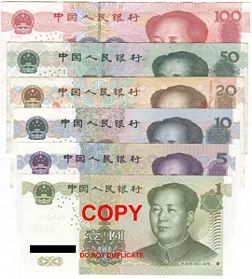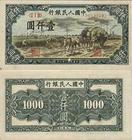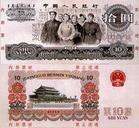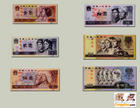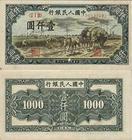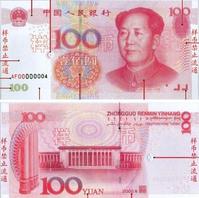CNY发表评论(0)编辑词条
The renminbi (sign: ¥; code: CNY) is the currency of the People's Republic of China (PRC), whose principal unit is the yuan. The renminbi is issued by the People's Bank of China, the monetary authority of the PRC. The ISO 4217 abbreviation is CNY, although it is also commonly abbreviated as "RMB". The Latinized symbol is ¥.
Etymology
A variety of currencies circulated in China during the Republic of China (ROC) era, most of which were denominated in the unit "yuan". Each was distinguished by a currency name, such as the fabi ("legal tender"), the "gold yuan", and the "silver yuan". The word yuan in Chinese literally means round, after the shape of the coins. The Korean and Japanese currency units, won and yen respectively are cognates of the yuan and have the same Chinese character representation, but in different forms, also meaning round in Korean and Japanese. However, they do not share the same names for the subdivisions.
As the Communist Party of China took control of ever larger territories in the latter part of the Chinese Civil War, its People's Bank of China began in 1948 to issue a unified currency for use in Communist-controlled territories.
Production and minting
A display in a Chinese bank detailing how to discern genuine 100 and 20 RMB notes from counterfeit versions.
Renminbi currency production is carried about by a state owned corporation, China Banknote Printing and Minting (CBPMC) headquartered in Beijing. CBPMC uses a network of printing and engraving and minting facilities around the country to produce banknotes and coins for subsequent distribution. Banknote printing facilities are based in Beijing, Shanghai, Chengdu, Xi'an, Shijiazhuang, and Nanchang. Mints are located in Nanjing, Shanghai, and Shenyang. Also, high grade paper for the banknotes is produced at two facilities in Baoding and Kunshan. The Baoding facility is the largest facility in the world dedicated to developing banknote material according to its website. In addition, the People's Bank of China has its own printing technology research division which researches new techniques for creating banknotes and making counterfeiting more difficult.
Coins
In 1955, aluminium 1, 2 and 5 fen coins were introduced. In 1980, brass 1, 2, and 5 jiao and cupro-nickel 1 yuan coins were added, although the 1 and 2 jiao were only produced until 1981, with the last 5 jiao and 1 yuan issued in 1985. In 1991, a new coinage was introduced, consisting of an aluminium 1 jiao, brass 5 jiao and nickel-clad-steel 1 yuan. Issuance of the 1 and 2 fen coins ceased in 1991, with that of the 5 fen halting a year later. The small coins were still made for annual mint sets, and from the beginning of 2005 again for general circulation. New designs of the 1 and 5 jiao and 1 yuan were introduced in between 1999 and 2002. The fen and jiao have become increasingly unnecessary as prices have increased. Chinese retailers tend to avoid decimal values (such as ¥9.99), opting instead for integer values of yuan (such as ¥9 or ¥10).
The use of coins varies from place to place. For example, coins are more often used for values less or equal to 1 yuan in Shanghai and Shenzhen but banknotes of the lower value are more often used than coins in Beijing and Xi'an
Banknotes
In 1955, notes (dated 1953), were introduced in denominations of 1, 2 and 5 fen, 1, 2 and 5 jiao, and 1, 2, 3, 5 and 10 yuan. Except for the three fen denominations and the 3 yuan, notes in these denominations continue to circulate, with 50 and 100 yuan notes added in 1980 and 20 yuan notes added in or after 1999.
The denomination of each banknote is printed in Chinese. The numbers themselves are printed in financial Chinese numeral characters, as well as Arabic numerals. The denomination and the words "People's Bank of China" are also printed in Mongol, Tibetan, Uyghur and Zhuang on the back of each banknote. The right front of the note has a tactile representation of the denomination in Chinese braille starting from the fourth series.
人民币简介
人民币是中华人民共和国的法定货币。其正式的ISO 4217简称为CNY(China Yuan),不过国际上更常用的缩写是RMB(Ren Min Bi);在数字前一般加上“¥”表示人民币的金额。
《中华人民共和国中国人民银行法》第三章第十五条规定:“中华人民共和国的法定货币是人民币”。 1948年12月1日中国人民银行成立时,开始发行第一套人民币;1955年3月1日开始发行第二套人民币;1962年4月15日开始发行第三套人民币;1987年4月27日开始发行第四套人民币;1999年10月1日开始发行第五套人民币。形成了包括纸币与金属币、普通纪念币与贵金属纪念币等多品种、多系列的货币体系。目前第一、二、三套人民币都已经停止流通,市场上流通的人民币以第五套为主,还有少量第四套人民币。
人民币的单位为元(圆)(人民币元Renminbi Yuan,简写“RMB”,以“¥”为代号)。人民币辅币单位为角分。人民币没有规定法定含 金量,它执行价值尺度、流通手段、支付手段等职能。
目前,市场流通的人民币券别分别:1、2、5角,1、2、5、10、20、50、100元。按照法律规定,人民币中元币以上为主币,其余角币、分币为辅币(但现在分币几乎退出流通)。 形成主辅币三步进位制,即1元 =10角=100分。按照材料的自然属性划分有金属币(亦称硬币)、 纸币(亦称钞票)。无论纸币、硬币均等价流通。
中华人民共和国的法定货币是人民币(可缩写成RMB),中国人民银行是国家管理人民币的主管机关,负责人民币的设计、印制和发行。人民币的单位为元,人民币的辅币单位为角、分。1元等于10角,1角等于10分。中华人民共和国自发行人民币以来,历时50多年,随着经济建设的发展以及人民生活的需要而逐步完善和提高,至今已发行五套人民币,形成纸币与金属币、普通纪念币与贵金属纪念币等多品种、多系列的货币体系。除1、2、5分三种硬币外,第一套、第二套和第三套人民币已经退出流通,目前流通的人民币,是中国人民银行自1987年以来发行的第四套人民币和1999年发行的第五套人民币,两套人民币同时等值流通。
历史上的人民币
第一套人民币
1948年12月1日,中国人民银行成立并发行第一套人民币,共12种面额62种版别,其中1元券2种、5元券4种、10元券4种、20元券7种、50元券7种、100元券10种、200元券5种、500元券6种、1000元券6种、5000元券5种、10000元券4种、50000元券2种。
第二套人民币
第二套人民币于1955年3月1日开始发行,同时收回第一套人民币。第二套人民币和第一套人民币折合比率为1:10000。第二套人民币共有1分、2分、5分、1角、2角、5角、1元、2元、3元、5元、10元11个面额,其中1元券有2种,5元券有2种,1分、2分和5分券别有纸币、硬币2种。为便于流通,自1957年12月1日起发行1分、2分、5分三种硬币,与纸分币等值流通。
第三套人民币
第三套人民币于1962年4月20日发行,共有 1角、2角、5角、1元、2元、5元、10元7种面额、13种版别,其中1角券别有4种(包括1种硬币),2角、5角、1元有纸币、硬币2种。1966年和1967年,又先后两次对1角纸币进行改版,主要是增加满版水印,调整背面颜色。
第四套人民币
为了适应经济发展的需要,进一步健全中国的货币制度,方便流通使用和交易核算,中国人民银行自1987年4月27日,发行第四套人民币。共有1角、2角和5角、1元、2元、5元、10元、50元、100元9种面额,其中1角、5角、1元有纸币、硬币2种。与第三套人民币相比,增加了50、100元大面额人民币。为适应反假人民币工作需要,1992年8月20日,又发行了改版后的1990年版50、100元券,增加了安全线。
第五套人民币
1999年10月1日,中国人民银行陆续发行第五套人民币,共有1元、5元、10元、20元、50元、100元八种面额,其中1角、5角为硬币,1元有纸币、硬币2种。第五套人民币根据市场流通需要,增加了20元面额,取消了2元面额,使面额结构更加合理。
流通领域
1、 港澳
2、 台湾
3、其它地区
人民币在朝鲜的外汇商店可以自由使用。
4、 人民币在越南少数地区主要是北部边境可以使用。
识别假币要点
识别人民币纸币真伪,通常采用“一看、二摸、三听、四测”的方法:
一看:
1、看水印:第五套人民币各券别纸币的固定水印位于各券别纸币票面正面左侧的空白处,迎光透视,可以看到立体感很强的水印。100元、50元纸币的固定水印为毛泽东头像图案。20元、10元、5元纸币的固定水印为花卉图案。
2、看安全线:第五套人民币纸币在各券别票面正面中间偏左,均有一条安全线。100元、50元纸币的安全线,迎光透视,分别可以看到缩微文字“RMB100”、“RMB50”的微小文字,仪器检测均有磁性;20元纸币,迎光透视,是一条明暗相间的安全线,10元、5元纸币安全线为全息磁性开窗式安全线,即安全线局部埋入纸张中,局部裸露在纸面上,开窗部分分别可以看到由微缩字符“¥10”、“¥5”组成的全息图案,仪器检测有磁性。
3、看光变油墨:50元 光变油墨印刷
第五套人民币100元券和50元券正面左下方的面额数字采用光变墨印刷。将垂直观察的票面倾斜到一定角度时,100元券的面额数字会由绿变为蓝色;50元券的面额数字则会由金色变为绿色。
4、看票面图案是否清晰,色彩是否鲜艳,对接图案是否可以对接上。第五套人民币纸币的阴阳互补对印图案应用于100元、50元和10元券中。这三中券别的正面左下方和背面右下方都印有一个圆形局部图案。迎光透视,两幅图案准确对接,组合成一个完整的古钱币图案。
5、用5倍以上放大镜观察票面,看图案线条、缩微文字是否清晰干净。第五套人民币纸币各券别正面胶印图案中,多处均印有微缩文字,20元纸币背面也有该防伪措施。100元微缩文字为“RMB”和“RMB100”;50元为“50”和“RMB50”;20元为“RMB20”;10元为“RMB10”5元为“RMB5”和“5”字样。
二摸:
1、摸人像、盲文点、中国人民银行行名等处是否有凹凸感。第五套人民币纸币各券别正面胶印图案中,多处均印有微缩文字,20元纸币背面也有该防伪措施。100元微缩文字为“RMB”和“RMB100”;50元为“50”和“RMB50”;20元为“RMB20”;10元为“RMB10”5元为“RMB5”和“5”字样。
二摸:2、摸纸币是否薄厚适中,挺括度好。
三听:
即通过抖动钞票使其发出声响,根据声音来分辨人民币真伪。人民币的纸张,具有挺括、耐折、不易撕裂的特点。手持钞票用力抖动、手指轻弹或两手一张一弛轻轻对称拉动,能听到清脆响亮的声音。
四测:
即借助一些简单的工具和专用的仪器来分辨人民币真伪。如借助放大镜可以观察票面线条清晰度、胶、凹印缩微文字等;用紫外灯光照射票面,可以观察钞票纸张和油墨的荧光反映;用磁性检测仪可以检测黑色横号码的磁性。
摸人像、盲文点、中国人民银行、国徽行名等处是否有凹凸感。
与“CNY,人民币”相关的词条
→如果您认为本词条还有待完善,请 编辑词条
词条内容仅供参考,如果您需要解决具体问题
(尤其在法律、医学等领域),建议您咨询相关领域专业人士。
0

同义词: 暂无同义词
关于本词条的评论 (共0条)发表评论>>




